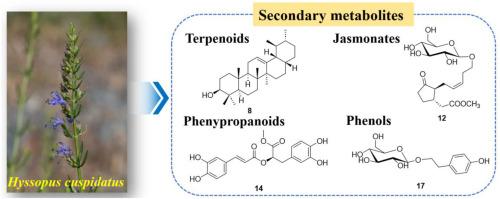Secondary metabolites from the arial parts of Hyssopus cuspidatus Boriss. and their chemotaxonomic significance
IF 2
4区 生物学
Q4 BIOCHEMISTRY & MOLECULAR BIOLOGY
引用次数: 0
Abstract
A phytochemical investigation of aerial parts of Hyssopus cuspidatus Boriss. led to the isolation of twenty compounds 1–20, including terpenoids (1−11), jasmonates (12 and 13), phenylpropanoids (14−16), and phenols (17−20). Compound 12 was determined as a new natural occurring, which was initially reported as a synthetic product. The structures of these structures were identified based on extensive spectroscopic methods as well as comparison with literature data. Compounds 10–12 were firstly acquired from the Lamiaceae family. Compounds 1, 3, 5–8, 13, 17, 19, and 20 were isolated from H. cuspidatus for the first time and also newly identified within the genus Hyssopus. The chemotaxonomic significance of these isolated compounds was also described.

虎耳棘虫幼虫次生代谢物的研究。以及它们的化学分类意义
牛膝草地上部分的植物化学研究。分离得到20个化合物1 - 20,包括萜类化合物(1−11)、茉莉酸酯(12和13)、苯丙素(14−16)和酚类化合物(17−20)。化合物12被确定为一种新的天然产物,最初是作为合成产物报道的。这些结构的结构是基于广泛的光谱方法以及与文献数据的比较来确定的。化合物10 ~ 12为首次从紫唇科植物中分离得到。化合物1、3、5 ~ 8、13、17、19和20为首次从cuspidatus中分离得到,也是在Hyssopus属中新分离到的化合物。本文还描述了这些分离化合物的化学分类意义。
本文章由计算机程序翻译,如有差异,请以英文原文为准。
求助全文
约1分钟内获得全文
求助全文
来源期刊

Biochemical Systematics and Ecology
生物-进化生物学
CiteScore
3.00
自引率
12.50%
发文量
147
审稿时长
43 days
期刊介绍:
Biochemical Systematics and Ecology is devoted to the publication of original papers and reviews, both submitted and invited, in two subject areas: I) the application of biochemistry to problems relating to systematic biology of organisms (biochemical systematics); II) the role of biochemistry in interactions between organisms or between an organism and its environment (biochemical ecology).
In the Biochemical Systematics subject area, comparative studies of the distribution of (secondary) metabolites within a wider taxon (e.g. genus or family) are welcome. Comparative studies, encompassing multiple accessions of each of the taxa within their distribution are particularly encouraged. Welcome are also studies combining classical chemosystematic studies (such as comparative HPLC-MS or GC-MS investigations) with (macro-) molecular phylogenetic studies. Studies that involve the comparative use of compounds to help differentiate among species such as adulterants or substitutes that illustrate the applied use of chemosystematics are welcome. In contrast, studies solely employing macromolecular phylogenetic techniques (gene sequences, RAPD studies etc.) will be considered out of scope. Discouraged are manuscripts that report known or new compounds from a single source taxon without addressing a systematic hypothesis. Also considered out of scope are studies using outdated and hard to reproduce macromolecular techniques such as RAPDs in combination with standard chemosystematic techniques such as GC-FID and GC-MS.
 求助内容:
求助内容: 应助结果提醒方式:
应助结果提醒方式:


